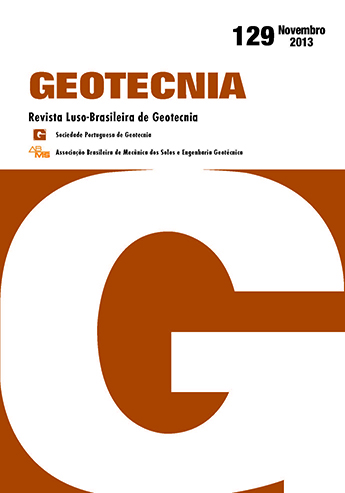A 2D discrete particle model for rock fracture: formulation and calibration
DOI:
https://doi.org/10.14195/2184-8394_129_4Keywords:
Particle model, Rock fracture, Parametric studiesAbstract
Detailed rigid particle models have been proposed for modelling fracture in quasi-brittle materials. In the present study, a 2D rigid particle model that has been developed to study fracture phenomena in rock is adopted. The particle assemblies are created using a particle generation algorithm that generates polygonal shaped particles based on the Laguerre Voronois of the circular particle gravity centres of an initial circular particle assembly. The particles are considered to interact through a multiple contact point model where the contact width and the contact location are defined given the Voronoi tessellation. The particle model is validated against known triaxial and Brazilian test results of a granite rock. Several parametric studies are presented showing the influence of the elastic and strength micromechanical parameters on both the macroscopic elastic and strength properties. Finally, a reference is made to the relevance of adopting a bilinear tensile/shear softening contact model in order to obtain coherent ultimate tensile values in direct tensile tests and in Brazilian tests.
Downloads
References
Azevedo, N. (2003). A rigid particle discrete element model for the fracture analysis of plain and reinforced concrete. PhD Thesis. Heriot-Watt University, Scotland.
Azevedo, N.; Lemos, J.V. (2005). A generalized rigid particle contact model for fracture analysis, International Journal for Numerical and Analytical Methods in Geomechanics, 29, pp. 269-285.
Azevedo, N.; Lemos, J.V. (2011). Particle geometry effect in rock fracture using a rigid particle discrete element method. Congress on Numerical Methods in Engineering. Coimbra.
Bieniawski, Z. (1967). Mechanism of brittle fracture of rock. International Journal of Rock Mechanics and Mining Science & Geomechanics Abstracts, 4, pp. 395-430.
Brace, W.; Paulding, B.; Scholz, C. (1966). Dilatancy in the fracture of crystalline rocks. Journal of Geophysical Research, 71, pp 3939–3953.
Cho, N.; Martin C.D.; Sergo D.C. (2007). A clumped particle model for rock. International Journal of Rock Mechanics & Mining Sciences, 44, pp. 997-1010.
Cundall, P.A. (1971). A computer model for simulating progressive, large-scale movements in blocky rock systems. Proceedings of the Symposium of the International Society for Rock Mechanics, Nancy 2, No.8.
Cundall, P.A.; Strack, O.D.L. (1979). A discrete numerical model for granular assemblies. Géotechnique, 29, No. 1, pp. 47-65.
Cundall, P.A. (1987). Distinct element models of rock and soil structure. Analytical and Compu ta - tio nal Methods in Engineering Rock Mechanics, E. T. Brown, Ed., Ch. 4, pp.129-163. London: George Allen & Unwin.
Diederichs, M.S. (2000). Instability of hard rock masses: the role of tensile damage and relaxation. PhD Thesis. University of Waterloo.
Diederichs, M.S. (2003). Rock Fracture and Collapse Under Low Confinement Conditions. Rock Mechanics and Rock Engineering, 36, pp. 339-381.
Erarslan, N.; Williams, D. (2012). Experimental, numerical and analytical studies on tensile strength of rocks. International Journal of Rock Mechanics & Minning Sciences, 49, pp. 21-30.
Fahimifar, A.; Malekpour, M. (2012). Experimental and numerical analysis of indirect and direct tensile strength using fracture mechanics concepts. Bulletin of Engineering Geology and the Environment, 71, pp. 269–283. Springer.
Hentz, S.; Daudeville, L.; Donze, V. (2004). Identification and Validation of a discrete element model for concrete, Journal of Engineering Mechanics ASCE, 130 (6), pp. 709-719.
Hoek, E.; Brown, E.T. (1980). Underground excavations in rock, Institute of Mining and Metallurgy. London.
Itasca, UDEC (2004). Universal Distinct Element Code, Version 4.0, Itasca consulting group, Minneapolis.
Kazerani, T.; Zhao, J. (2010). Micromechanical parameters in bonded particle method for modelling of brittle material failure. International Journal for Numerical and Analytical Methods in Geomechanics, 34, pp. 1877-1895.
Kazerani, T. (2011). Micromechanical study of rock fracture and fragmentation under dynamic loads using discrete element method. PhD Thesis. Lausanne, Switzerland.
Klanphumeesri, S. (2010). Direct tension tests of rock specimens. MSc Thesis. Suraranee University of Technology, Thailand.
Lan, H.; Martin, C.D.; Hu, B. (2010). Effect of Heterogeneity of brittle rock on micromechanical extensile behaviour during compression loading. Journal of Geophysical Research, 115, pp. 1-14.
Lemos, J. V. (2004). Os modelos de elementos discretos em geomecânica - evolução e perspectivas futuras. Geotecnia - Revista da Sociedade Portuguesa de Geotecnia, 100, pp. 333-344.
Lilliu, J.; Van Mier, M. (2003). 3D lattice type fracture model for concrete, Engineering Fracture Mechanics, 70 (7-8), pp. 841-927.
Martin, C.D.; Chandler, N.A. (1994). The progressive fracture of Lac du Bonnet granite. International Journal of Rock Mechanics and Mining Sciences and Geomechanics Abstracts, 31, pp. 643–659.
Meguro K.; Hakuno, M. (1989). Fracture analysis of concrete structure by the modified distinct element method. Structural Engineering / Earthquake Engineering, 6 (2), pp. 283-294.
Okabe, A.; Boots, B.; Sugihara, K. (1992). Spatial tesselations. Concepts and Applications of Voronoi Diagrams. Wiley Series in Probability and Statistics.
Potyondy, D.; Cundal, P. (1996). Modeling rock using bonded assemblies of circular particles, 2nd North American Rock Mechanics Symposium, Aubertin et al., Eds, Balkema, pp. 1937-1944.
Potyondy, D.O.; Cundall, P.A. (2004). A bonded-particle model for rock. International Journal of Rock Mechanics & Mining Sciences, 41, pp. 1329-1364.
Potyondy, D. (2010). A grain-based model for rock: approaching the true microstructure. Pro - ceedings, Bergmekanikk i Norden 2010 — Rock Mechanics in the Nordic Countries, 41, C. C. Li et al., Eds, pp. 225-234. Norway.
Rokugo, K. (1989). Testing method to determine tensile softening curve and fracture energy of concrete. Fracture toughness and fracture energy, pp. 153-163. Balkema.
Schlangen, E.; Garboczi, E. (1997). Fracture simulation of concrete using lattice models: Com pu - ta tional aspects. Engineering Fracture Mechanics, 57, pp. 319-332.
Underwood, P. (1983). Dynamic relaxation. Computational Methods for Transient Analysis, pp. 246-265. (T. Belytschko & T.J.R. Hughes, Eds.) New York: North-Holland.
Vasconcelos, G. (2005). Investigação experimental na mecânica da alvenaria de pedra: Carac te - ri zação de granitos e comportamento de paredes antigas de alvenaria de pedra. PhD Thesis. Universidade do Minho, Portugal.
Wang, Y.; Tonon, F. (2009). Modeling Lac du Bonnet granite using a discrete element model, International Journal of Rock Mechanics & Mining Sciences, 46, pp. 1124-1135.




